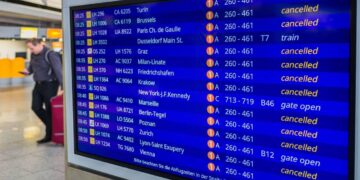India’s aviation regulator, the Directorate General of Civil Aviation (DGCA), has ramped up runway safety measures in response to the tragic incident at Japan’s Haneda Airport. The DGCA issued a comprehensive circular urging airports across the country to adopt proactive strategies to avert future runway incursions.
DGCA Key Recommendations
The DGCA’s recommendations center around several critical aspects:
- Runway Safety Teams: Airports must establish dedicated runway safety teams, fostering open communication and rapid response to potential hazards.
- Advanced Technology: Upgrading to cutting-edge surveillance technology will significantly boost situational awareness for ATC and other airport personnel, giving them a real-time picture of traffic movements.
- Thorough Training and Compliance: Pilots, air traffic controllers, engineers, and airport vehicle operators must receive rigorous training, emphasizing strict adherence to standard operating procedures (SOPs).
- Emergency Protocols: The DGCA mandates that airports, airlines, and ATCs prepare robust contingency plans in the event of stop bar malfunctions or other safety system failures.
- Human Factors Focus: Recognizing how fatigue, stress, and other human factors can play a role in runway incursions is crucial. The DGCA stresses the need for a proactive approach and fostering a strong safety culture amongst all aviation stakeholders.
The Haneda Incident: A Grim Reminder
The severity of runway incursions was tragically underscored by the January 2nd Haneda Airport disaster. A colliding passenger airliner and Japanese Coast Guard aircraft tragically resulted in fatalities. This event served as a stark catalyst for the DGCA to reassess runway safety protocols within India.
India’s Own Near-Miss
The DGCA’s move highlights the urgency of the issue, particularly in light of India’s close call last August at Delhi airport. In that incident, an alert ATC narrowly prevented a runway collision involving two Vistara flights.
A Proactive Stance for Increased Safety
The new circular reflects the DGCA’s unwavering commitment to aviation safety. By proactively addressing these critical areas, India’s airports can further minimize risks and ensure passenger safety remains the top priority.
Read also: DGCA Unveils Game-Changing Rules: More Rest, Safer Skies for Indian Pilots!
For Quick Aviation Updates connect with Us.
Follow us on Google News
FAQs
- What is a runway incursion? A runway incursion occurs when an aircraft, vehicle, person, or object improperly enters an active runway, presenting a potential collision hazard.
- Why did the DGCA issue a circular after the Haneda Airport incident? The tragic collision at Haneda tragically underscored the dangers of runway incursions. India’s DGCA took swift action to review its own protocols and issue new guidance to proactively reinforce runway safety practices within the national aviation sector.
- What is a runway safety team? A runway safety team involves key airport stakeholders (ATCs, pilots, ground staff, etc.), creating a collaborative forum to identify potential hazards, analyze past incidents, and develop proactive strategies to reduce risks on runways.
- How can technology improve runway safety? Cutting-edge surveillance systems enhance situational awareness, providing real-time insights into traffic movements on the runway and surrounding areas for ATCs and other responsible personnel.
- What are some SOPs that can prevent runway incursions? Standard Operating Procedures (SOPs) provide explicit instructions on communications, clearances, vehicle entry onto runways, and other critical actions aimed at ensuring safe and clear separation between aircraft and other runway traffic.
- What is the purpose of a stop bar? Stop bars are illuminated red lights embedded in the runway surface, providing a clear visual barrier and instructing taxiing aircraft or vehicles to halt for clearance.
- What are the human factors that can contribute to runway incursions? Factors like fatigue, distraction, miscommunication, and complacency can increase the risk of errors leading to runway incursions. Recognizing how these factors influence behavior is essential for preventive action.
- What happened in the Delhi airport near-miss? A potentially disastrous runway incursion almost occurred at Delhi airport when two Vistara flights were simultaneously cleared for takeoff on the same runway.
- Is the DGCA’s circular in response to the near-miss incident in Delhi? While the Delhi near-miss undoubtedly raised awareness of the issue, the DGCA’s circular takes a broader, proactive approach influenced by both that incident and the international concern raised by the Haneda disaster.
- Will these new regulations make flying in India safer? The DGCA firmly believes that implementing these measures will substantially enhance aviation safety in India. By prioritizing a proactive approach, investing in advanced technology, and emphasizing meticulous adherence to procedures, the likelihood of runway incursions will be reduced, boosting overall confidence in the safety of flying in India.








